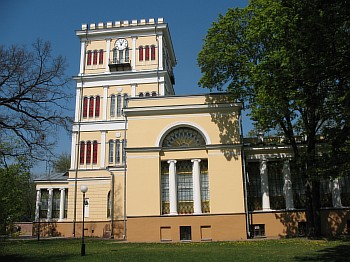
| Science Culture Cooperation Library Multimedia |
|
Main - - Culture - Architectural monuments - Gomel region Gomel palace and park complex
Gomel palace and park complex. Gomel Palace of the Rumyantsevy and Paskevichi was built in the Empire style; it is the compositional centre of the palace and park ensemble, which includes a landscape park, Peter and Paul Cathedral and the chapel. The palace was founded in 1785 by General-Field Marshal P. Rumyantsev-Zadunaiski in the place of defensive structures and the wooden castle of M. Chertoriyski. Before 1834 it belonged to Rumyantsev, in 1834-1856 years - to Field-Marshal I.Paskevich. In the years 1777-1796 the main building was erected (architect J. Alekseev, with the participation of C. Blanca). In the years 1800-1805 two office wings were built (architect J. Clark), in the years 1837-1851 the reconstruction and completion were made (architect A. Idzkovsky): the main building was connected to the wings, galleries, flanked by square in the pavilion; a four-storey tower was built in Neo-Gothic style as well as a pavilion with a skylight; changes were made to the solution of facades. The palace was renovated in 1856, 1919-1920; it was destroyed and burned in 1941-1943 and restored and renovated in 1969.The main building is one of the first examples of classical Palladian buildings in Belarus with close to a square shape of the plan and dome completion. A two-storey building with a belvedere has a ground floor, entrance ramp and semi-circular terrace from the riverside. The main facade is emphasized by a four-columned portico of Corinthian order,the facade from the river has a six-column portico. The scenes are disjoint by pilasters. The layout of the Palace is enfilade. A hall with niches and a shelf, surrounded by rows of Corinthian columns, coated with artificial marble dominates in the interior. In the decoration of the interiors stucco moulding and paintings are used (Master B. Vincenti ). On the ground floor there is a red, white and a small living room, a dining room, a study and a bedroom. The galleries represented by twelve-bay Ionic colonnades, were designed to house collections of paintings and minerals. The monumental bulk of pavilions have complex triple windows with coloured glass windows. In the interiors the pavilions are decorated with Ionic pilasters; they are decorated with mouldings in the form of masks and garlands. The facades of the tower which has a serrated end are disjoint by pilasters, wide cornice bands, grouped high windows. From the south side the tower is adjacent by a glazed veranda, in front of which there is an exedra; from the north part it has a pavilion, completed with a round light drum
© National Academy of Sciences of Belarus, 2011
|

